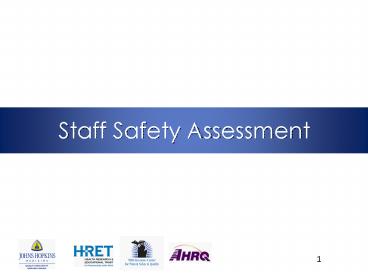Staff Safety Assessment - PowerPoint PPT Presentation
1 / 23
Title: Staff Safety Assessment
1
Staff Safety Assessment
1
2
Learning Objectives
- To understand Step 2 of CUSPIdentify Defects
- To understand how to Implement the Staff Safety
Assessment - To understand ways to use results of the Staff
Safety Assessment
2
3
Goals
- To identify defects
- To leverage the wisdom of the front line worker
- To prepare a list of improvement opportunities
that has face validity and provides a focus for
CUSP activities.
3
4
On the CUSP Stop BSI
CUSP
CLABSI
- Educate staff on science of safety
- Identify defects
- Assign executive to adopt unit
- Learn from one defect per quarter
- Implement teamwork tools
- Remove Unnecessary Lines
- Wash Hands Prior to Procedure
- Use Maximal Barrier Precautions
- Clean Skin with Chlorhexidine
- Avoid Femoral Lines
4
5
The CUSP Team
- The smaller group that spreads the intervention
- to the rest of the unit
5
6
Education and engagement activities on the unit
- BSI Providing Evidence, Modeling the line
placement steps stopping insertions that violate
protocol having one-on-one talks where
necessary - Facilitating CUSP Activities
6
7
Comprehensive Unit-based Safety Program (CUSP)
- Educate staff on science of safety
(www.safercare.net) - Identify defects
- Assign executive to adopt unit
- Learn from one defect per quarter
- Implement teamwork tools
We are here
You are here!!!
7
8
Identify Defects
- Review error reports, liability claims, sentinel
eventsor M and M conference - Ask staff how the next patient will be harmed
8
9
Identifying Defects
- What SHOULD you know?
- What DO you know?
9
10
Transparency
- Making project and progress visible to everyone
10
11
How are We Going to Harm the Next Patient?
- One way to make harm visible-- get staff thinking
about safety and how to improve it
11
12
Step 2 Staff Identify Defects
- Frontline caregivers are the eyes and ears of
patient safety - Identify clinical or operational problems that
negatively impact patient safety (have or could) - Use the Staff Safety Assessment form (Part of
CUSP manual) - How will the next patient will be harmed in our
unit - What can be done to minimize patient harm or
prevent this safety hazard - ICU managers and team review suggestions, set the
agenda for discussion with executive partner
12
13
13
14
Step 2 Staff Identify Defects
- What Team Leaders need to do
- Hand out a Staff Safety Assessment form to all
staff, clinical and non-clinical, in the unit - Establish a collection box or envelope
- Identify and group common defects (such as
communication, medications, patient falls,
supplies, etc.) - Summarize as frequencies (i.e., what percent of
responses were for communication)
14
15
Prioritize Defects
- List all defects
- Discuss with staff what are the three greatest
risks
15
16
Step 2 Staff Identify Defects
- Report the identified defects to staff, executive
partner - ICU managers and CUSP team prioritize defects
identified by the potential level of risk to the
patient - Select one to work on with support of Executive
- Step 2 should be ongoing
16
17
17
18
18
19
CUSP Team activities-keeping on track
- Team meetings (recommend monthly)
- Review of data (monthly)
- Meet w/ Exec Partner (monthly or more)
- Executive review of data (monthly)
- Presentations to hospital colleagues
- (leadership, frontline staff, board)
19
20
20
21
Comprehensive Unit-based Safety Program (CUSP)
- Educate staff on science of safety
(www.safercare.net) - Identify defects
- Assign executive to adopt unit
- Learn from one defect per quarter
- Implement teamwork tools
We are here
You are here!!!
21
22
What Should you do NOW?
- CLABSI Collect Submit Baseline Monthly BSI
data - CUSP Preparation Assemble team/Schedule
meetings - CUSP Implementation
- Science of Safety Training for all staff
- Identify Defects How will patients be harmed?
- www.safercare.net
- www.onthecuspstopbsi.org
22
23
References
- Pronovost PJ, Berenholtz SM, Needham DM.
Translating evidence into practice A model for
large scale knowledge translation. BMJ. 2008
337a1714. - Pronovost P, Needham D, Berenholtz S, et al. An
intervention to decrease catheter-related
bloodstream infections in the ICU. NEJM. 2006
355(26)2725-2732. - Pronovost PJ, Berenholtz SM, Goeschel C, et al.
Improving patient safety in intensive care units
in michigan. J Crit Care. 2008 23(2)207-221. - Pronovost P, Weast B, Rosenstein B, et al.
Implementing and validating a comprehensive
unit-based safety program. J Pat Safety. 2005
1(1)33-40. - Pronovost PJ, Weast B, Bishop K, et al. Senior
executive adopt-a-work unit A model for safety
improvement. Jt Comm J Qual Saf. 2004
30(2)59-68.
23































